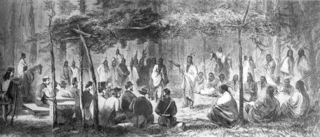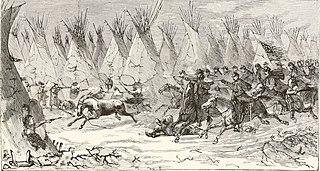
During the Age of Discovery, a large scale colonization of the Americas, involving a number of European countries, took place primarily between the late 15th century and the early 19th century. The Norse had explored and colonized areas of Europe and the North Atlantic, colonizing Greenland and creating a short term settlement near the northern tip of Newfoundland circa 1000 AD. However, due to its long duration and importance, the later colonization by the European powers involving the continents of North America and South America is arguably more well-known.

Genocide denial is the attempt to deny or minimize the scale and severity of an instance of genocide. Denial is an integral part of genocide and includes the secret planning of genocide, propaganda while the genocide is going on, and destruction of evidence of mass killings. According to genocide researcher Gregory Stanton, denial "is among the surest indicators of further genocidal massacres".

The encomienda was a Spanish labour system that rewarded conquerors with the labour of conquered non-Christian peoples. The labourers, in theory, were provided with benefits by the conquerors for whom they laboured, including military protection and education. The encomienda was first established in Spain following the Christian reconquest of Moorish territories, and it was applied on a much larger scale during the Spanish colonization of the Americas and the Spanish East Indies. Conquered peoples were considered vassals of the Spanish monarch. The Crown awarded an encomienda as a grant to a particular individual. In the conquest era of the early sixteenth century, the grants were considered to be a monopoly on the labour of particular groups of indigenous peoples, held in perpetuity by the grant holder, called the encomendero; starting from the New Laws of 1542, the encomienda ended upon the death of the encomendero, and was replaced by the repartimiento.

Population figures for the Indigenous peoples of the Americas prior to European colonization have been difficult to establish. By the end of the 20th century, most scholars gravitated toward an estimate of around 50 million, with some historians arguing for an estimate of 100 million or more.
David Edward Stannard is an American historian and Professor of American Studies at the University of Hawaii. He is particularly known for his book American Holocaust, in which he argues that European colonization of the Americas after the arrival of Christopher Columbus resulted in some of the largest series of genocides in history.

Guenter Lewy is a German-born American author and political scientist who is a professor emeritus of political science at the University of Massachusetts Amherst. His works span several topics, but he is most often associated with his 1978 book on the Vietnam War, America in Vietnam, and several controversial works that deal with the applicability of the term genocide to various historical events, where Lewy denies both the Romani genocide and the Armenian genocide.

The first wave of European colonization began with Spanish and Portuguese conquests and explorations, and primarily involved the European colonization of the Americas, though it also included the establishment of European colonies in India and in Maritime Southeast Asia. During this period, European interests in Africa primarily focused on the establishment of trading posts there, particularly for the African slave trade. The wave ended with the British annexation of the Kingdom of Kandy in 1815 and the founding of the colony of Singapore in 1819.
Holocaust trivialization refers to any comparison or analogy that diminishes the scale and severity of the atrocities that were carried out by Nazi Germany during the Holocaust. The Wiesel Commission defined trivialization as the abusive use of comparisons with the aim of minimizing the Holocaust and banalizing its atrocities. Originally, holocaust meant a type of sacrifice that is completely burnt to ashes; starting from the late 19th century, it started to denote extensive destruction of a group, usually people or animals. The 1915 Armenian genocide was described as a "holocaust" by contemporary observers.

Is the Holocaust Unique? Perspectives on Comparative Genocide is a 1995 book about the Holocaust uniqueness debate, edited by Alan Rosenbaum. In the book, scholars compare the Holocaust to other well-known instances of genocide and mass death. The book asks whether there are any historical parallels to the Jewish Holocaust and whether Armenians, Romani people, American Indians, or others have undergone a comparable genocide.
A Little Matter of Genocide: Holocaust and Denial in the Americas 1492 to the Present (1997) is a book which was written by Ward Churchill. A Little Matter of Genocide surveys ethnic cleansing from 1492 to the present. Churchill compares the treatment of North American Indians to historical instances of genocide by communists in Cambodia, Turks against Armenians, and Europeans against the Gypsies, as well as Nazis against the Poles and Jews.
Although a variety of infectious diseases existed in the Americas in pre-Columbian times, the limited size of the populations, smaller number of domesticated animals with zoonotic diseases, and limited interactions between those populations hampered the transmission of communicable diseases. One notable infectious disease that may be of American origin is syphilis. Aside from that, most of the major infectious diseases known today originated in the Old World. The American era of limited infectious disease ended with the arrival of Europeans in the Americas and the Columbian exchange of microorganisms, including those that cause human diseases. Eurasian infections and epidemics had major effects on Native American life in the colonial period and nineteenth century, especially.
The genocide of Indigenous peoples, colonial genocide, or settler genocide is the intentional elimination of Indigenous peoples as a part of the process of colonialism.
There are 17 indigenous tribes in Paraguay with the majority having their territories in the Chaco region. Tribes in this region include the Guaraní, Ayoreo, Toba-Maskoy, Aché and Sanapan which according to the census from 2002 number an estimated 86,000 or roughly around 2 per cent of the total population. These peoples have faced persecution particularly under the dictator Alfredo Strossner that some observers called a genocide.

The connection between colonialism and genocide has been explored in academic research. According to historian Patrick Wolfe, "[t]he question of genocide is never far from discussions of settler colonialism." Historians have commented that although colonialism does not necessarily directly involve genocide, research suggests that the two share a connection.
This is a select annotated bibliography of scholarly English language books and journal articles about the subject of genocide studies; for bibliographies of genocidal acts or events, please see the See also section for individual articles. A brief selection of English translations of primary sources is included for items related to the development of genocide studies. Book entries may have references to journal articles and reviews as annotations. Additional bibliographies can be found in many of the book-length works listed below; see Further Reading for several book and chapter-length bibliographies. The External links section contains entries for publicly available materials on the development of genocide studies.

Denial of genocides of Indigenous peoples consists of a claim that has denied any of the multiple genocides and atrocity crimes, which have been committed against Indigenous peoples. The denialism claim contradicts the academic consensus, which acknowledges that genocide was committed. The claim is a form of denialism, genocide denial, historical negationism and historical revisionism. The atrocity crimes include genocide, crimes against humanity, war crimes, and ethnic cleansing.

Indigenous response to colonialism has varied depending on the Indigenous group, historical period, territory, and colonial state(s) they have interacted with. Indigenous peoples have had agency in their response to colonialism. They have employed armed resistance, diplomacy, and legal procedures. Others have fled to inhospitable, undesirable or remote territories to avoid conflict. Nevertheless, some Indigenous peoples were forced to move to reservations or reductions, and work in mines, plantations, construction, and domestic tasks. They have detribalized and culturally assimilated into colonial societies. On occasion, Indigenous peoples have formed alliances with one or more Indigenous or non-Indigenous nations. Overall, the response of Indigenous peoples to colonialism during this period has been diverse and varied in its effectiveness. Indigenous resistance has a centuries-long history that is complex and carries on into contemporary times.

The historiography of Indigenous genocide is the study of how these type of genocides have been documented and interpreted by historians throughout the colonial age up to today.

Native American genocide in the United States refers to the characterization of the substantial population decline of American Indians as a form of genocide. The question of whether the significant population decline constitutes genocide is debated amongst scholars. Debates are ongoing over whether the entire process, or specific periods and local occurrences, meet the legal definition of genocide. Raphael Lemkin, who coined the term "genocide," considered the colonial displacement of Native Americans by English and later British settlers as a historical example of genocide. However, others, like historian Gary Anderson, contend that genocide does not accurately characterize any aspect of American history, suggesting instead that ethnic cleansing is a more appropriate term.












